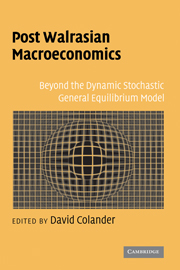Book contents
- Frontmatter
- Contents
- List of Contributors
- Foreword by Alan Kirman
- Introduction
- PART I WHERE WE ARE IN MACRO AND HOW WE GOT THERE
- PART II EDGING AWAY FROM THE DSGE MODEL
- PART III LEAPING AWAY FROM THE DSGE MODEL
- 9 Agent-Based Computational Modeling and Macroeconomics
- 10 Multi-agent Systems Macro: A Prospectus
- 11 Agent-Based Financial Markets: Matching Stylized Facts with Style
- PART IV LETTING THE DATA GUIDE THEORY
- PART V POLICY IMPLICATIONS
- Bibliography
- Index
10 - Multi-agent Systems Macro: A Prospectus
Published online by Cambridge University Press: 02 December 2009
- Frontmatter
- Contents
- List of Contributors
- Foreword by Alan Kirman
- Introduction
- PART I WHERE WE ARE IN MACRO AND HOW WE GOT THERE
- PART II EDGING AWAY FROM THE DSGE MODEL
- PART III LEAPING AWAY FROM THE DSGE MODEL
- 9 Agent-Based Computational Modeling and Macroeconomics
- 10 Multi-agent Systems Macro: A Prospectus
- 11 Agent-Based Financial Markets: Matching Stylized Facts with Style
- PART IV LETTING THE DATA GUIDE THEORY
- PART V POLICY IMPLICATIONS
- Bibliography
- Index
Summary
While macroeconomics has never denied the essentially microeconomic character of most economic activity, it is only in the past 30–40 years that the quest for microeconomic foundations for macro has assumed center stage. There appear to be myriad motivations for this quest, from logical necessity to ultimate completeness to elements of the “Lucas critique.” While no single motivation is universally cited, few would argue with the general notion that a macroeconomics with microfoundations would be at least as useful as macro without microfoundations.
Unfortunately for macro today, the quest for microfoundations has taken on quixotic proportions, with little sign of the quarry on the horizon and the conquistadors constantly jousting among themselves concerning the most fertile direction to turn their pursuit.
In this chapter I argue that the quest for microfoundations is desirable, even admirable, but that doing so via analytical and numerical techniques is surely very difficult. In lieu of such conventional formulations, it is today feasible to instantiate relatively large populations of purposive agents in software and study their dynamics and evolution without need for the heroic assumptions and gross simplifications that are the norm in macroeconomics today.
Today very little is known about how to actually build agent models directly relevant to macroeconomic concerns, and so in place of results I substitute statements about feasibility and potential. But history is on our side in this quest, providing us exponentially more powerful machinery over time, and virtually guaranteeing that at some point somewhere this quest will succeed.
- Type
- Chapter
- Information
- Post Walrasian MacroeconomicsBeyond the Dynamic Stochastic General Equilibrium Model, pp. 203 - 220Publisher: Cambridge University PressPrint publication year: 2006
- 5
- Cited by



